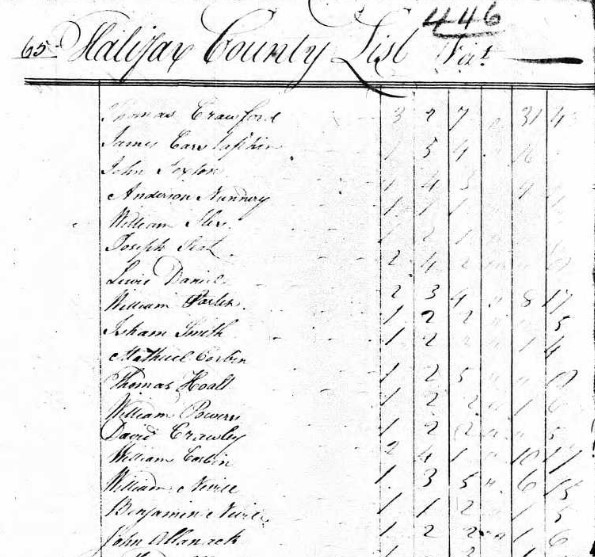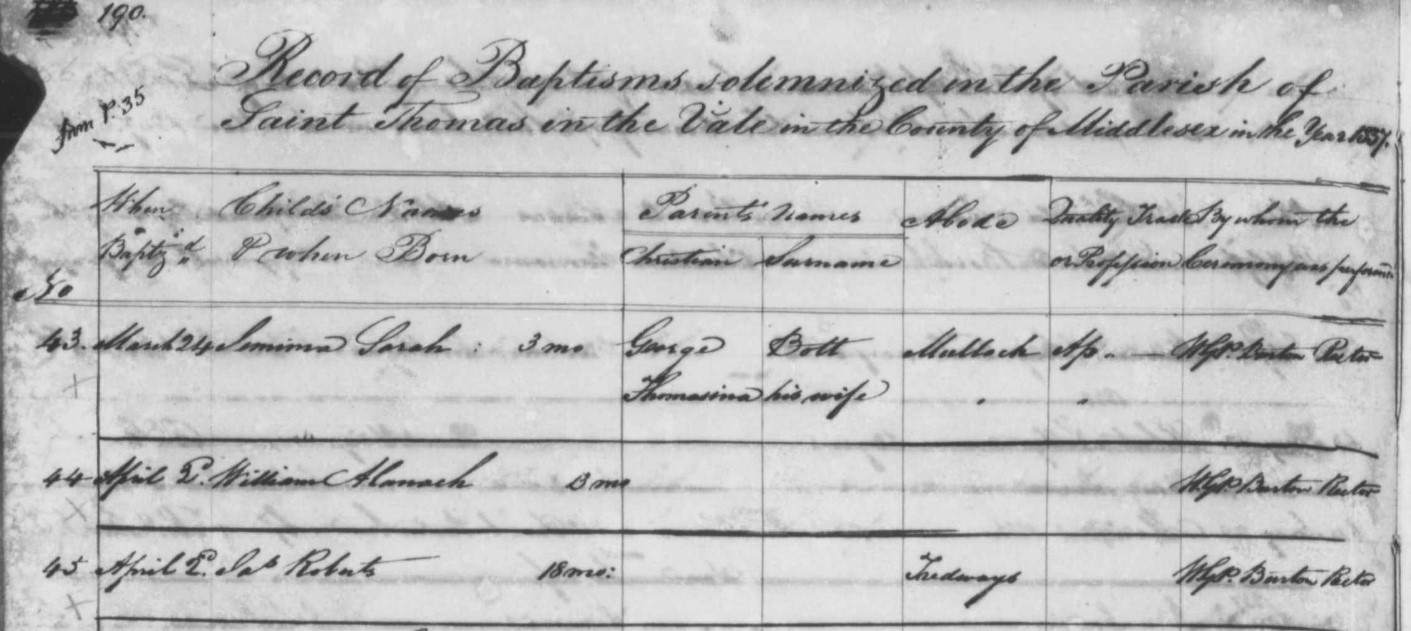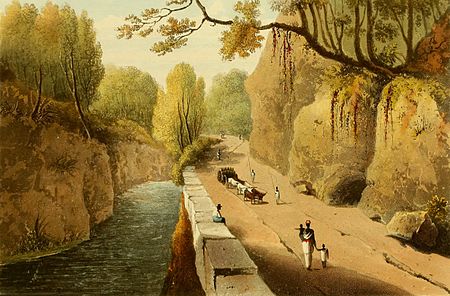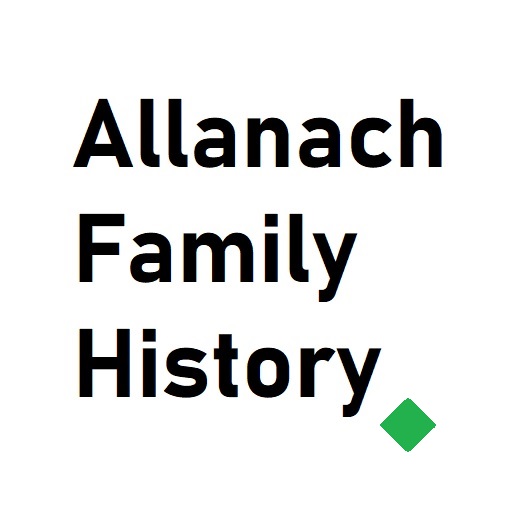Introduction
Research has sadly uncovered two Allanachs who worked as overseers in the Jamaica plantations from the 1820s onwards as well as two slave children named Allanach. There is also a fifth Allanach (William Alanach) who was baptised aged 3 months in April 1837 in the area of Jamaica where William and Alexander were working. Additionally, there are three possible Allanachs in Jamaica in 1819, and a ‘John Allanach’ in North Carolina who owned six slaves in 1790.
Returning to the documented Allanachs in Jamaica in the 1820s-30s. I believe the overseers William and Alexander Allanach to be brothers and the sons of William Allanach and Isobel Grassich evidenced by their parish birth records below.


They would have been born into relative poverty – Alexander’s entry in 1803 lists William’s profession as a servant in Belnabodach (Glen Nochty). You can read an extensive history of the Belnabodach farm here. In 1799, William and Isobel were also fined £1 10s by the Kirk (likely for having William and Alexander’s elder brother John out of wedlock).
Like so many other Scots, it is likely that they ended up in Jamaica either through poverty or coercion. We will likely never know the exact reason.
Whilst in Jamaica, they worked as overseers at notorious plantation estates such as Williamsfield and Rodney Hall, where they were fined for assaulting workers on several occasions. They seem to have also been involved in the Scottish Kirk in Jamaica and William has reached the rank of Lieutenant in the local militia by 1839.
Unfortunately, I neither have any definitive records yet as to whether William and Alexander remained in Jamaica or returned to Scotland, nor what happened to a slave named Alick Allanach.
Additionally, there is one ‘outlier’ record for a John Allanach in North Carolina in the 1790 census, showing him owning 6 slaves.
1790
A ‘John Allanach’ in Halifax County, North Carolina appears in the 1790 census. It shows him owning 6 slaves and living with 3 female relatives. I have not been able to link John to any other Allanachs or to a birth in Scotland, and he remains an ‘outlier’ record.

1819
The recent release of the Church of England Parish register Transcripts on Ancestry has shown an additional three hits for ‘Allanick’ to the ones mentioned above. It is not certain if there is any relation or intent to name the babies ‘Allanach’ or whether ‘Allanaick’ is a different surname entirely.
- 1819 – George Allanick – St Thomas in the East
- Allanick – Male – St Thomas in the East
- Allanick – Female – St Thomas in the East
1829
Allanach Slaves
Unfortunately there is evidence that there were slaves named ‘Allanach’. An 1829 Registry from St Thomas in the East Parish in Jamaica (likely to be Hermitage Estate from number of slaves under owner Robert Anderson in 1829 (Details). Henry and Alick Allanach.
The exact reasons as to why these two young boys were called ‘Allanach’ we may never know. It could be that the slave owner was not particularly imaginative and called the slave children after overseers he knew. A second possibility is that they are the children of the Allanach brothers. Given Scottish naming conventions of giving a first born the name of the father, Alick (Alec) could be the son of Alexander Allanach. ‘Creole’ in the register also points to a white father, or could mean that they were born on the island as opposed to being transported there from Africa.
Sadly, there are no further records I can find for Alick Allanach and Henry Allanach is shown in the register as dying aged 2 years old.

1831
Slave Rebellion and Church Division
Following the Christmas 1831 Jamaica slave rebellion, the Presbyterian missionaries refused to join the newly formed Colonial Church Union, and were then, like other missionaries in Jamaica, branded Sectarians.
From Twenty-Nine Years in the West Indies and Central Africa: a Review of the Missionary Work and Adventure, 1829-1858, by Rev Hope Masterton Waddell, (Scottish Missionary Society), published 1863 :
The Colonial Church Union was a combination of the planters and others, formed immediately after the insurrection was extinguished, for the purpose of expelling all Sectarian missionaries from the island. Comprising the greater part of the white population, throughout the western half of the island, and having sympathy of many others, of whom better things were expected, it began to acquire a dominant influence in public affairs.
The Unionists tried to draw the Scottish missionaries into their schemes.Owing, perhaps, to the number of Scotchmen in the colony, and the fact that our Missionary Society was in part connected with the Church of Scotland, they exempted us from the term Sectarian, and professed a design to erect Scotch kirks in all the parishes, as a new branch of the island Church Establishment. But we disapproved both of their objects and their offers. We had no desire to separate from the great missionary cause; nor to be allied with the only representative of the Church of Scotland (Rev James Wordie of the Kingston Kirk) in the country, or with the Established Church of the colony. Then the blandishments became curses, and pretended friends real enemies. We were denounced as Scotch Sectarians, worthy only of being treated like all the others
1832
Calls for a Scottish Kirk in Jamaica
On 13 October 1832 the Jamaica Royal Gazette published an account of Rev James Wordie being invited to St Thomas in the East by several Gentlemen of influence, and who are anxious that their people should receive religious instruction from a Clergyman of the Church of Scotland
From the Jamaica Royal Gazette, 13 October 1832
Another Scotch Kirk.
We are glad to learn that another Scotch Church is about to be erected in the Parish of St Thomas in the East, in the Blue Mountain Valley District. The Rev Mr Wordie returned on Saturday from that quarter, having been invited to visit it by several Gentlemen of influence, and who are anxious that their people should receive religious instruction from a Clergyman of the Church of Scotland, who have been always equally distinguished for their rational and scriptural sentiments, their loyalty, their diligence, and zeal. They are hard-working men, free themselves from enthusiasm, and able to keep their hearers free from it. We do not know how benevolence to our labourers, or patriotism to the community, can be better shown, than by contributing to raise Kirks in the different Parishes of the Island. The Scotch Clergy will have the confidence of the proprietors and managers; they will be the friends and guides of the poor, a companion for the higher ranks, and a comforter for the lower. They are too well informed to push forward improvement by great and rapid strides; they know that men acquire new habits by imperceptible degrees; and that any sudden change may just be as reasonably expected, as it would be to expect, that a child put to bed at night should rise in the morning a full grown man!
It is but justice to the inhabitants of the different parishes where Mr Wordie has been, to state that they have applied to him of their own accord, and requested him to direct them in procuring Clergymen of the Church of Scotland. Such have been his efforts, and such the public confidence in his character and abilities, that he has made a tour round the island, and put into operation no less than six new Churches, built and building solely by private subscriptions, in the short period of about two years. Ibid.(Courant of Tuesday).
From the Jamaica Royal Gazette, 22 December 1832 PS, page 19
William Allanach contributes to Kirk Subscription List
( From the Jamaica Royal Gazette, 22 December 1832 PS, page 19 )
In December 1832, the Jamaica Royal Gazette published a subscription list for the purpose of building a Kirk in the parish of St Thomas in the Vale. It shows William Allanach donating £5, 6S, 8d .(roughly £600 in today’s money.)
1834
Abolition of Slavery in Jamaica & creation of ‘Apprenticeship system’
The British Parliament held two inquires as a result of the loss of property and life in the 1831 Baptist War rebellion. Their reports of the conditions of the slaves contributed greatly to the abolition movement and helped lead to the passage of The Slavery Abolition Act of 1833, formally ending slavery in Jamaica on August 1, 1834. However, the act stipulated that all slaves above the age of 6 on the date abolition took effect, were bound (indentured) in service to their former owners’, albeit with a guarantee of rights, under what was called the “Apprenticeship System”. The length of servitude that was required varied based on the former slaves’ responsibilities with “domestic slaves” owing 4 years of service and “agriculture slaves” owing 6. In addition to the apprentice system, former slave owners were to be compensated for the loss of their “property.” By 1839, “Twenty Million Pounds Sterling” was paid out to the owners of slaves freed in the Caribbean and Africa under the 1833 Abolition Act, half of whom were absentee landlords residing in Great Britain.
The apprentice system was unpopular amongst Jamaica’s “former” slaves — especially elderly slaves — who unlike slave owners were not provided any compensation. This led to protests. In the face of mounting pressure, a resolution was passed on August 1, 1838 releasing all “apprentices” regardless of position from all obligations to their former masters.
1836
The Allanach brothers feature in magistrate reports in 1836 and are included in the Westminster Parliamentary Papers (Relative to the Abolition of Slavery). Note on page 346 on the papers (page preceeding), Table 2 is defined as ‘List of fine imposed on overseers etc during the month of February 1836’, with table 3 the same but for March 1836.


A £10 fine in 1836 is worth £1270 as of today (2022).
You can find out more about the Papers Relative to the Abolition of Slavery here.
1837
I have also discovered a baptisim record for a three month old child named William Alanach dated 2nd April 1837. The location is the Parish of Saint Thomas in the Vale, County of Middlesex, Jamaica, therefore consistent with where William Allanach was working. Interestingly no parent names are given.

1839
The 1839 Jamaica Almanac lists William Allanach as a lieutenant in the Middlesex (Regiment) Militia of foot for St Thomas’ in the Vale under the following commanders :
Colonel, William Lord
Lieut.-Colonel, Peter F. Garrigues
Major, Henry Lowndes
Locality
James Hakewill’s ‘A picturesque tour of the island of Jamaica’ 1825
A picturesque tour of the island of Jamaica from drawings made in the years 1820 and 1821 by James Hakewill gives a first hand account of life in 1820s Jamaica and covers some of the places and estates where the Allanach brothers worked.

St Thomas in the Vale from Mount Diablo
The road over Mount Diablo, to open a more easy communication between the South and North side of the Island, was formed about fifty years since. The elevation is gradual and easy to its summit, and the toil of mounting it is amply repaid by the varied and extensive prospect which it commands; the whole parish of St. Thomas in the Vale backed by the high grounds of St. David’s, and the more distant blue mountains being spread before the eye. In the wood beneath us are the buildings of the Ivy Sugar Estate, now thrown up, and lately purchased by George Barriffe, Esq.: beyond is Charlemont Penn, the property of Sir Alexander Grant, Bart, and more distant, the works on Treadways, the property of Henry Dawkins, Esq. The immense height and consequent distance renders the markings of other estates too indistinct for the pencil. The greater part of the parish is comprized within the Vale called Sixteen Mile Walk. This Vale is about eleven miles in length, and eight in width. It is neither flat nor swampy, but diversified throughout with gentle risings and slopes: the soil is fertile; for the most part a red coarse earth, mixed with clay, or a dark mould, with a whitish marl. The Vale is almost daily throughout the year overcast with a thick fog, which begins to rise slowly on the approach of evening, grows denser as the night advances, becomes gradually diffused into all the contiguous vales or inlets among the surrounding mountains, is heaviest about the dawn of day, and remains settled until the sun has warmed and agitated the air: then it rises higher, expanding in the atmosphere; and between the hours of eight and nine in the forenoon, it begins to flow away in two principal streams, the one westward among the mountains on that side; and the other southward following the course of the river. The air of this parish is in general reported healthy, and the habitations throughout the Vale, being for the most part built upon rising grounds, are not liable to damps. This tract was among the first settled with sugar plantations, and what it produces now of that commodity is of an excellent quality, but the land is thought to be much worn. The road itself cannot be better described than in the words of Beckford; and not having the English work at hand, we must quote from the French translation, which is fortunately in our possession. “Il est peu de routes que je préfère à celles que l’on voit dans la plus grande partie de l’isle entre de hautes hayes de campêche; elles sont loin d’une régularité monotone; souvent elles forment de magnifiques berceaux du plus beau verd; ici, elles sont découvertes et laissent distinguer vingt arbustes différens; là elles se resserrent, c’est plus un sentier qu’un grand chemin, et des tilleuls en fleurs y répandent leurs parfums dans les airs; tout auprès s’élève le cocotier; ses rameaux forment le dais le plus magnifique, et ses fruits suspendus à la portée du voyageur l’invitent à y chercher une fraîcheur salutaire et des sues parfumés et exquis. Les prairies sont peuplées de troupeaux; le bambou y étale la délicatesse de ses plumes et la richesse de ses ombres; le cédre bâtard y balance ses larges ombelles, et l’arbre du cachou y attire les yeux par la couleur dorée de ses fruits.”

The Bog Walk
The Parish of St. Thomas in the Vale is very generally known as The Walks, which are again subdivided and distinguished as Bog Walk, the Six Mile Walk, the Sixteen Mile Walk, &c. Bog Walk is the high road from Spanish Town, to the parish of St. Thomas in the Vale, St. Ann, St. Mary, and generally to the north side of the Island. The road for the first five or six miles from the former town runs through a fine open country, and then enters the mountains, clothed with the most luxuriant foliage of every variety of form and grandeur, and of every variety of tint; the road passes along at their base, and divides the narrow space, with the Rio Cobre retained in its channel, where necessary, by a stone parapet, as seen in the accompanying view.
The Rio Pedro, Rio d’Oro, Rio Magno, and the Black River, fall into the Rio Cobre, near the Bog Walk. From the Tavern (at the opening of the pass into St. Thomas in the Vale) the latter river, after passing Spanish Town, enters the sea at Hunt’s Bag, near Fort Augusta.

Williamsfield Estate
Williamsfield Estate, in the Parish of St. Thomas in the Vale, according to what can be gathered from the old negroes (there being no early records), was first settled, nearly eighty years ago, by Mr. Needham, who was at that time a large proprietor in the Island; but while in its infancy (within three or four years after it was commenced), it was purchased by a Mr. Harvey, who came from Barbadoes, and was a merchant in Kingston, From Mr. Harvey it became the property of Daniel Lascelles, Esq., brother to the first Baron Harewood, from whom it descended to the present Earl. It contains 2,998 acres of land, including Sandy Gut, a small estate which was purchased and added to it in 1815: something more than 300 acres of this is in canes, about 500 fallow and in pasture; the remainder in excellent negro provision grounds, woodland and ruinate, but a great part of the two latter is incapable of any cultivation, from being extremely rocky and steep: the present crops exceed 300 hogsheads of good sugar, with a pretty good proportion of rum. There are 304 negroes (negroes and people of colour) on the estate. The jobbing, or hired negro labour, is however considerable. The nearest shipping-places to which a waggon can go, are Port Henderson and Passage Fort, both of which are twenty-three or twenty-four miles distant. The principal road across the island, from Spanish Town to St. Mary’s, passes through the estate, on the bank of a pleasant rivulet, between the works and dwelling house: the cane field and pasture land is a continuation of small steep hills with water-courses passing between them; the wood covers the hills towering over these. The soil is in general light and poor, but with a judicious use of manure, which the situation of the cane land renders the application of, a hard task for the stock, gives fair returns.
Nightingale Grove, in St. Dorothy’s, is likewise the property of the Earl of Harewood. At the time of its purchase, by Mr. Daniel Lascelles, it was a penn, but was soon after converted into a sugar estate.—G. W. Hamilton, Esq., Attorney.
Conclusion
As the song below shows, Scotland and Jamaica share a long history. I suspect there are more documents out there to further the stories of Alexander, William, Alick and Henry, but the ones uncovered so far paint a sad picture of slavery, religious and civil division and infant mortality.
